I have chosen to categorize Chinese padlocks into eight groups:
Iron padlocks – completely made of iron – with shackle and ward springs
Box-shaped, large and small of varying materials, with shackle with ward springs and key
Box-shaped, large and small of bronze, with shackle with ward springs and turning key
Box-shaped slide-key locks, large and small of bronze, with shackle with ward springs and key
Keyless warded locks (combination locks)
Good fortune (“wedding”) locks, large and small, with rounded shapes and made of varying materials. With shackle with ward springs and key.
Locks of varying materials and varying forms, such as people, animals, musical instruments, bottles, knives, etc.
Modern padlocks of varying materials and technologies in various shapes, all with turning keys
Iron padlocks
Some very large old Chinese padlocks are made of forged iron. They are strongly influenced by Arabian locks.
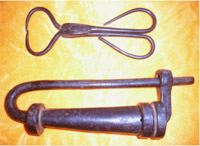 |
 |
| Iron padlock, (18th C?) The tong-like object is the key. The pincers compress the ward spring through the tiny holes in the lock body. One of the keyholes is visible in the thicker part of the lock. Photo by the author. |
Iron padlock, (18th C?). Photo by the author. |
Box-shaped padlocks
Box-shaped padlocks of all sizes are very common. The lock bodies are made of cast brass, with an opening on one short end for a key that matches the ward springs. The other short end is detachable and contains the shackle and ward springs. When the key is inserted in the keyhole, the bit compresses the springs, releasing the whole short end with the shackle and springs. The key to this lock has an angled bit with notches for the ward springs. In the oldest versions of this kind of lock, the shackle and springs were made of steel. One variety has various kinds of hidden keyholes, usually on the bottom of the lock, hidden by thin, moveable metal plates the same width and length as the lock. Another variant is locks that open with four different steps.
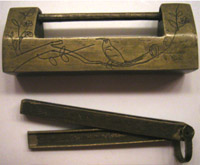 |
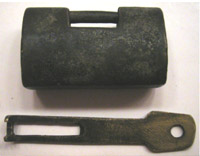 |
| Brass box lock, later type. Photos by the author |
Brass box lock, earlier type. Photos by the author |
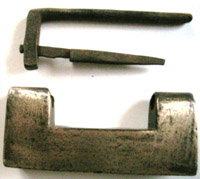 |
 |
| Brass box lock with shackle and ward springs of steel, c. 16th C. Photo by the author. |
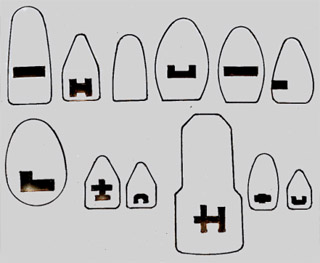 |
| Samples of the profiles and keyholes of box locks. Sketch by the author. |
Box-shaped padlocks as slide-key locks
The lock bodies are of cast brass and come in several sizes. The shapes vary somewhat, but usually one short end has one or more openings for one leg of the shackle with its ward springs. The other short end is solid. The whole underside of the lock body has narrow lengthwise double guides and a long narrow opening for the key.
When locked, the leg of the shackle with the ward springs is inserted in the short end of the lock body and the other is in a narrow conical tube attached to the bottom edge of the lock body. The lock opens when the key bit is inserted into the keyhole on the top of the lock and slid through the slot, compressing the ward springs so that the shackle can be pulled out.
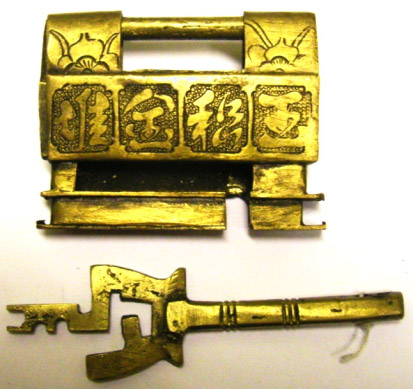 |
| Slide-key lock of cast brass. Photo by the author. |
Box-shaped padlocks with turning keys
A bronze box lock with a keyhole with a box of wards in the same material. In contrast to the above locks, these locks open with a turning key. When the key bit is turned, it compresses the ward springs and releases the short side with the shackle and ward springs. Another variety of these has only a keyhole and no box of wards.
This is an old lock concept, designed by the Romans in the 3rd century. It was also applied in some Viking-era padlocks in Birka and Helgö (see the figure in the article on the History of padlocks).
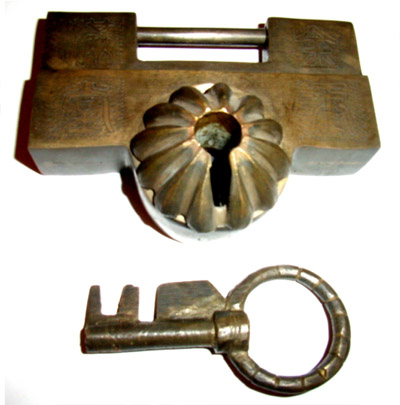 |
| Box-shaped padlock of cast bronze with turning key. Photo by the author. |
Keyless warded padlocks (combination locks)
The idea of combination or code locks is a nearly 1,000-year old Arabic invention, but it took several centuries before the idea reached Central Europe. Thus, it is likely that these locks were used in China before the 13th century or just after.
These keyless locks are opened by the turning of several rings or cubes. The surfaces of the rings or cubes have imprinted letters, numbers, or in this case, Chinese characters. Commonly each ring or cube is marked with four characters. Each must be turned to the correct position before the lock can be opened.
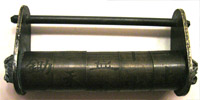 |
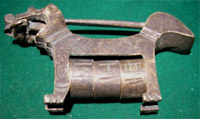 |
| Combination locks with five and three rings. Photos by the author. |
Good fortune padlocks (“wedding locks”)
These padlocks have more rounded shapes than the other box locks. The lock bodies are cast in brass or aluminum with an opening on one short side for a key that matches the ward springs. The other short end is detachable and has the shackle and ward springs attached to it. The lock opens when the key is inserted in the keyhole and the bit compresses the springs, releasing the whole short end so the shackles and springs can be pulled out. The key to this lock has a bit with notches for the ward springs.
 |
| Aluminum “wedding lock” with ornamentation in relief. Both sides shown. Photos by the author. |
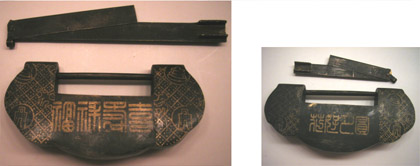 |
| Two bronze “wedding locks” of different sizes. Note the spade-coin decorations. Photos by the author. |
Padlocks of varying shapes
Padlocks of brass, bronze or aluminum in the shape of animals, insects, musical instruments, knifes and so on are very common in China. As stated above, the Chinese zodiac consists of twelve animals alternately representing the years, and all are represented in padlocks.
Each lock has an opening on one edge for a key that matches the ward springs. The shackle and ward springs are attached to the other side. The lock is opened when the key is inserted in the keyhole and the bit compresses the ward springs, allowing the shackle and springs to be drawn out. The keys to these locks usually have an angled bit with notches for the springs.
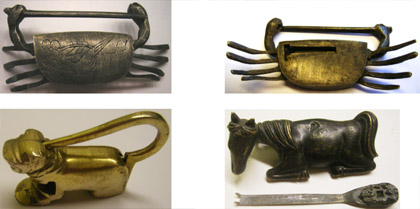 |
|
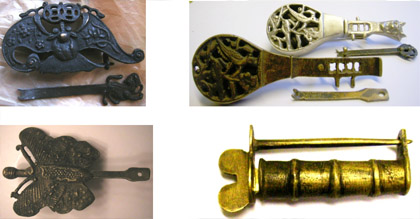
|
| Examples of locks of varying shapes and materials. Photos by the author. |
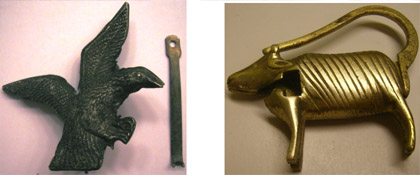 |
| Examples of locks of varying shapes and materials. Photos by the author. |
Modern padlocks
Modern padlocks came to China with foreign troops during World War II in the 1940s.
To conclude this article, I have chosen to include some pictures on the uses of Chinese padlocks in modern China. Modern padlocks “made in China” are in very common use throughout China. Over a thousand Chinese companies make padlocks, and huge numbers of them are exported to Europe and elsewhere.
Padlocks are used in many contexts and to a much larger extent than in the West, from the regal gates of an imperial palace to the barred gates of your average industrial workshop. From modern cities to ancient villages, padlocks are used to lock sliding doors, bars on doors, metal gates, wooden gates, doors, bicycles, mopeds, and motorcycles.
Palace gates locked with a padlock
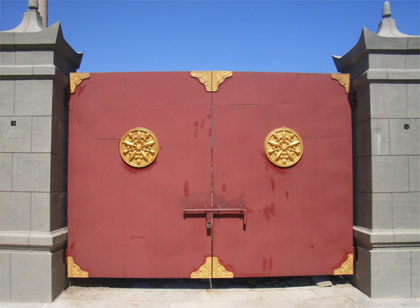 |
| Gate in the wall around the palace of the last emperor, Pu Yi, in Changchun in northern China. Note the padlock. Photo by the author. |
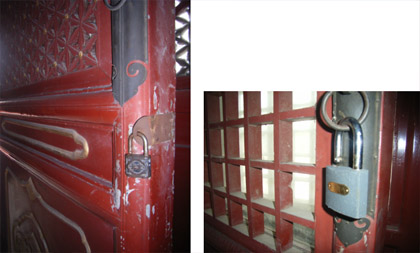 |
| New technology in an ancient environment. The use of modern Chinese padlocks in one of the buildings in Tian Tan Park (Huangqiongyu), Beijing. Photos by the author. |
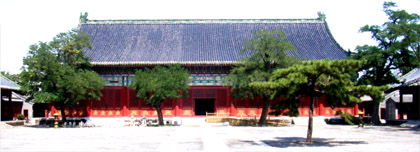 |
| One of the buildings in Tian Tan Park, Beijing: the Imperial Heavenly Vault. This is where the emperor changed clothes for the ceremonies in the nearby Temple of Heaven. Photo by the author. |
Newer padlocks
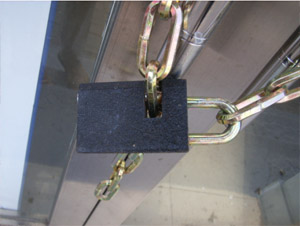 |
| Modern Chinese padlock on a mechanical workshop in Changchun. Photo by the author. |
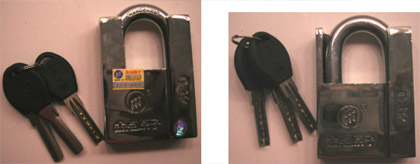 |
| Don’t these look a lot like the Abloy PL 342 and PL 362? |
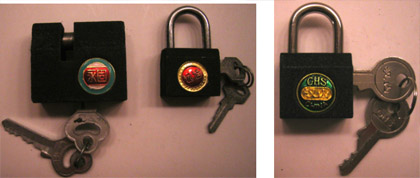 |
| More examples of modern Chinese padlocks. Photos by the author. |
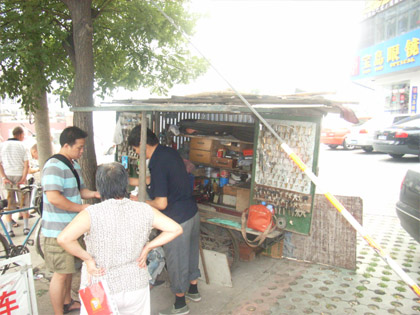 |
| Traveling key and lock salesman in Beijing. Photo by the author. |
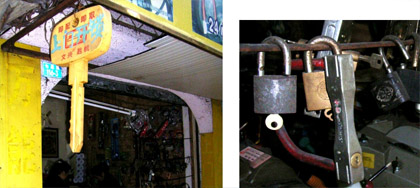 |
| Locksmith shop in Nanning in southern China. They also sold new locks of Chinese make. Photos by the author. |
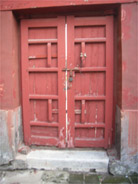 |
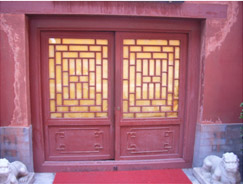 |
| Door locked with beam and padlock |
Door locked with a cylinder lock |
| Buildings in Tian Tan Park, Beijing. Photos by the author. |
References
Hsing-Hui Huang och Hong-Sen Yan, Mechanism Design of Ancient Chinese Splitting-spring Padlocks. (Diss.). 2004.
Pankofer, Heinrich, Schloss und Schlüssel. München 1973.
Samlung Ingo Schmoeckel, VorhängeSchlösser. Oberursel 2000.
Made of Iron. Exhibition catalogue, University of St Thomas Art Department. Houston, Texas 1966.